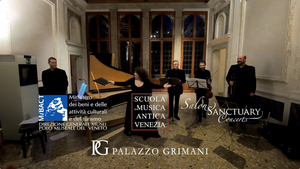Salon/Sanctuary Concerts Partners With Venetian Institutions For Early Music Concerts In Venice

As the 400th anniversary year of the great Venetian composer Barbara Strozzi (1619-1677) drew to a close, Salon/Sanctuary offered three original programs dedicated to "la virtuossissima cantatrice" in the stunning Renaissance edifice of Palazzo Grimani, the only Roman mannerist-inspired house in Venice.
Jessica Gould, the Founder and Artistic Director of Salon/Sanctuary Concerts, was honored with the invitation to conceive and perform a series of original programs of Venetian music by Marco Rosa Salva, the Director of the Scuola di Musica Antica Venezia, the early music school in residence at Palazzo Grimani. The invitation provided not only the opportunity for some characteristically inventive programming from Salon/Sanctuary, but also for the creation of a new resident ensemble, The Camerata Grimani.
Rosa Salva commented "The collaboration with Jessica Gould and Salon Sanctuary was a lucky and important occasion for the Scuola di Musica Antica. The activities we organize at the Grimani Museum benefited from three superb concerts dedicated to Barbara Strozzi and the Venetian seventeenth-century repertoire. They were welcomed with great enthusiasm by a very large audience, and it was a perfect way to start the concerts again after the difficult time and the forced closure due to the high water of last November."
Gould added "To be entrusted by a Venetian institution to program and perform Venetian music is a tremendous honor to me as an American Artistic Director and musician. It is a privilege to have earned the task of creating new programs to celebrate Strozzi in her own city in this important anniversary year, and a profound joy to share our programmatic perspective on her legacy with an audience of her fellow Venetians."
The Camerata Grimani Concerts
Barbara Strozzi e la sua eredità, the first concert on December 28th, explored Strozzi's artistic heritage, with works by her, her teacher Francesco Cavalli (1602 - 1676) and his teacher, the great Claudio Monteverdi (1567 - 1643). The performers were Jessica Gould, soprano, joined by Marco Rosa Salva, recorder, Diego Castelli, violin, Diego Cantalupi, archlute, and Davide Pozzi, harpsichord.
In the second concert on January 3rd (postponed from earlier in December on account of the flooding) Gould was joined by French mezzo-soprano Lila Hajosi to perform selections from Strozzi's only volume of sacred music, I Sacri Musicali Affetti (op. 5). The duo was accompanied by lutenist Giovanni Bellini, viola da gambist Francesco Tomei, and harpsichordist Federica Bianchi.
The third concert, on January 5th, featured Gould and Cantalupi in Ave Regina, a recital of seicento Venetian works that explored the idea of the regal feminine, sacred and secular, pagan and christian, through the lens of characters both exaulted and denigrated, in music composed entirely by men. Composers included Kapsberger, Legrenzi, Monteverdi, and Rigatti.
Future programming plans include interdisciplinary projects that interweave historical dance and baroque music, with the guidance and participation of historical dancer, stage director, musicologist and SMAV faculty member Ilaria Sainato.
Palazzo Grimani
The Palazzo Grimani of Santa Maria Formosa, a splendid example of Renaissance architecture in Venice also has extraordinary importance from the point of view of musical history.
The splendid Palazzo, now a state museum, is not only a space particularly suitable for music from an architectural and acoustic point of view, but it is also a place that had a crucial importance for the history of music in general and Venetian music in particular.
The Grimani of Santa Maria Formosa played a fundamental role in the history of drama for music, being founders and owners of the major Venetian opera houses. Claudio Monteverdi, Francesco Cavalli, Alessandro Scarlatti, Georg Friedrich Handel, Johann Adolph Hasse, Baldassare Galuppi, among others, wrote works for the Grimani theaters. The Academy of Animosi met in the palace of Santa Maria Formosa, chaired by Apostolo Zeno, to whom Alessandro Marcello was affiliated. The music academies that took place in the Palazzo are described in Charles Burney's The Present State of Music in France and Italy (1773), who was twice a guest.
The Grimani of Santa Maria Formosa were among the first, in the seventeenth century, to dedicate a theater to public opera, the SS. Giovanni e Paolo, then building the most sumptuous of the Venetian theaters, the S. Giovanni Grisostomo, and dedicating their theater of S. Samuele to the melodrama in the eighteenth century, first designed for comedy.
They were therefore in contact with all the major musicians engaged in the field: Monteverdi, The Coronation of Poppea was written for S. Giovanni and Paolo) Cavalli, Haendel, ( his only opera for Venice, Agrippina, was staged at S. Giovanni Grisosotomo), Hasse, Galuppi, just to mention the best known. The Grimani, although of a noble and wealthy family, did not disdain to deal directly with the management of theaters, as real impresarios, contracting with singers, librettists, composers, implementing very acute and aggressive economic strategies against competing theaters, reaching in some moments almost a monopoly on Venetian opera production.
Artistic and literary academies had their headquarters in this building, such as that of the Animosi, presided over by Apostolo Zeno, later the Venetian seat of Arcadia. Serenades and concerts usually took place during the meetings. For example, an academy of music is witnessed by Charles Burney).
To read more about the architecture and architectural history of Palazzo Grimani, click here.
Comments
Videos

